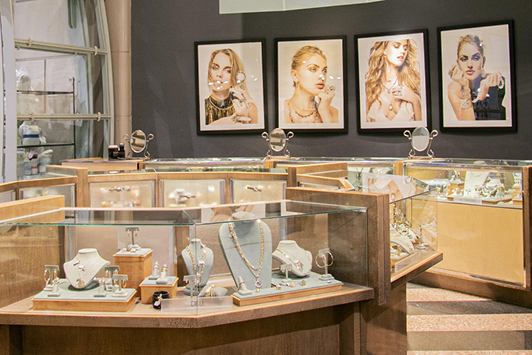 Image: Stanley Korshak
Image: Stanley Korshak
As the buyer of fine jewelry at
Stanley Korshak, Melissa Geiser evaluates a myriad of factors before adding a new designer to the Texas retailer’s roster. But her loyal and enthusiastic customer base gets her off to a good start.
“All my clients love jewelry,” she says. “They are really and truly collectors who enjoy wearing their jewelry and are fond of the designers we carry and fond of us.”
Founded in 1909, the specialty retailer has become an institution in Dallas and beyond with its reputation for luxury goods, superior service and a welcoming ambience. Geiser describes “a very social environment” where clients spend “hours in the store sitting and chatting” — even when not necessarily looking at jewelry. The store serves cocktails on Friday and Saturday, and the feeling of camaraderie is mutual among clients and staff.
“We know everyone, including their families. We’re like family,” says Geiser, who began her 30-year career as a seller in the jewelry department, moving into the buying office five years later. While she initially envisioned herself working in fashion, she admits to “loving jewelry more” — just like her clients, who tend to exhibit little interest in fashion. For that reason, Geiser merchandises the fine jewelry independently of the store’s other luxury departments.
Glitzy, subtle and in-between
Clients usually range in age from 50 to 60, although the demographic can extend from the “30s up to 85 or 90 years old,” according to Geiser. Knowledgeable and well-traveled, they are looking for jewelry that is “not being worn by every single person. They don’t want Cartier. My client already owns Cartier or is not interested in it.”
She further segments her customers into those who love the “very glitzy and diamondy” pieces, and those who favor “understated elegance — even if the piece features a large stone.” And in the middle is the group that “just wants something cute.”
The contemporary jewelry market is “always bubbling up with something new,” continues Geiser, and with an eye trained to “find the unique and wonderful,” she has noticed some
salient trends.
Diamonds top the list of most-desired stones, followed by sapphires. Color is in demand, particularly emeralds, which she says “had a lot of play this last season.” Rubies round out the gemstone category. “Special diamonds, [specifically] alluvials and Euro cuts,” are gaining in popularity, especially “anything that is uncharacteristic and has a story.”
Geiser sees a “real void” in her marketplace for white metals, which
tend to feature in traditional jewelry but not as much in designer lines like the ones she brings in. She also points to a return of shiny metal, noting that matte has been around for a long time. While she doesn’t think matte is going away, she has observed that many people have become receptive to shinier looks.
Will it sell?
Of course, trends are only one criterion for determining whether the store carries a given collection. Making that decision involves “a real discussion,” Geiser says.
In addition to evaluating the quality, craftsmanship and look, she strives to identify specific customers for a piece. “If the buying team and I can’t come up with names of people who might buy the collection, we may or may not take it.”
One benefit of the close relationship with clients, at least, is that “they listen to us. Based on their preferences for one designer, we can suggest pieces by another designer,” she says. Still, the decision to stock a piece is more about “whether it can sell, rather than the designer’s name. No one wants to invest in anything that doesn’t sell.”
When it comes to online sales, jewelry is one of the store’s most popular product categories (along with the men’s category). In terms of percentages, the less expensive pieces perform better online than those at higher price points, though the latter find buyers as well.
Meeting and greeting
Geiser is formulating Stanley Korshak’s marketing plans for 2022, which the company will implement later in the year. She cites trunk shows and personal appearances as the store’s most successful promotions, especially since they allow the clients — often collectors — to meet their favorite designers.
“It’s absolutely critical,” she says, adding that “our best event is a sit-down dinner with a designer and 20 to 30 people.” The “intimate and casual” environment is very conducive to sales. “The designers are very approachable, which makes it much easier to part with $25,000 or $50,000 or $100,000.”
Geiser believes the pandemic “allowed people to buy jewelry for themselves,” since they were not spending the money on clothes and decided jewelry was a great buy or investment. When the store reopened after the shutdown, the first customer to come in was an 80-year-old woman, she recalls, and Geiser is confident that people “are still coming.”
stanleykorshak.comArticle from the Rapaport Magazine - March 2022. To subscribe click here.